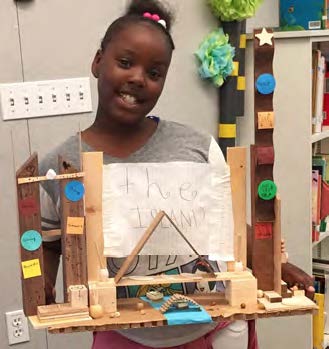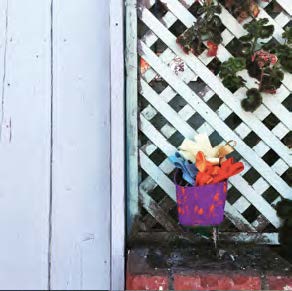TOMODACHI Japan “Day of Action” 2019
A collaboration with: Verde Elementary School, N. Richmond Community Housing Development Corporation, City of Richmond, Love Your Block, and Contra Costa County
During spring 2019, fifth grade students at Verde Elementary School in North Richmond, California, took on a local “real world” challenge. Professional architects and planners engaged the students in a series of hands-on studio workshops using the Y-PLAN 5-step methodology. They took on the challenge: How can we beautify the public spaces in our neighborhood while celebrating our community history and pride?


The students made models, maps and drawings to articulate their proposals to beautify the neighborhood and to make it “clean, green, and safe”. They did an amazing job of tackling some of the tough issues facing the community, and they did so with creativity, optimism and care. Their proposals included new soccer fields, an educational nature and art trail along Wildcat Creek, and themed pop-up parklets in degraded public spaces abutting the Creek. They also produced “community pride” public service posters and recommendations for murals to showcase these themes.


During the summer of 2019, one hundred high school students from Tohoku—the region hit by devastating earthquake and tsunami in 2011—visited UC Berkeley for three weeks. They were here to learn—through the Y-PLAN initiative—about how to be leaders and to build community by participating in a local community development project. Inspired by the 5th grade student work, the Japanese students also engaged in the Y-PLAN process as they focused on North Richmond. They generated a set of long-term and short-term recommendations about how the community might become more vibrant, creative, and connected. Within the framework of their long-term proposals, four groups of 25 students each also generated a plan to build out one small component of their vision during a Day of Action. They had to adhere to the following criteria: 
• Proposal for the Day of Action must be part of your overall presentation on Friday, July 26.
• It should respond directly to the project question and should support the long-term proposals for change.
• The proposal should be very real and implementable at one of the selected sites.
• Materials should cost no more than $200 US Dollars.
• Your team of 25 students must be able to implement the proposed idea within 2 hours.
Adults from Y-PLAN and our partner organizations helped lay the groundwork for the Day of Action. Together we selected three sites that the Japanese students could use as the focus of their recommendations.
1. Market Street – a boarded up public housing project sitting on a prominent corner next to two major throughways: “The abandoned house can be a positive bright spot in the neighborhood.”

1. Market Street – a boarded up public housing project sitting on a prominent corner next to two major throughways: “The abandoned house can be a positive bright spot in the neighborhood.”

2. A slice of public land used as a dumping ground abutting Wildcat Creek and facing the main thoroughfare, Fred Jackson Way: “This lot can be restored to help people learn about + enjoy the creek.

3. The dead end on Truman Ave abutting Wildcat Creek, where trash collects and old cars are parked: “A beautiful fence can inspire people to take pride in neighborhood.”
Various adult professionals and volunteers worked behind the scenes during the days prior to the Day to structure success for the students. We negotiated with the County Public Works  Department to ascertain what public property could be available; what the restrictions were—and what safety precautions had to be made. The Love Your Block team met with neighbors, property owners, the Housing Authority, and others to get buy-in and approvals to put artwork on walls, or on buildings. Love Your Block worked with the Y-PLAN team to check out tools from the Richmond Tool library and to secure material donations. The City of Richmond and Love Your
Department to ascertain what public property could be available; what the restrictions were—and what safety precautions had to be made. The Love Your Block team met with neighbors, property owners, the Housing Authority, and others to get buy-in and approvals to put artwork on walls, or on buildings. Love Your Block worked with the Y-PLAN team to check out tools from the Richmond Tool library and to secure material donations. The City of Richmond and Love Your  Block collaborated to make a large quantity of mulch available. And the Y-PLAN team drew up plans, purchased materials, secured donations, and prepped mural and parklet sites. Volunteers from the National Park Service cut, cleaned, and transported 16 tree log rounds to the parklet site to be decorated by the youth and used for seating. Robert Rogers from Supervisor John Gioia’s office helped everyone navigate the bureaucracy required to bring students into the neighborhood, to work on public space, and to secure approvals. Simultaneously, back in the Y-PLAN studio, students worked in teams on their
Block collaborated to make a large quantity of mulch available. And the Y-PLAN team drew up plans, purchased materials, secured donations, and prepped mural and parklet sites. Volunteers from the National Park Service cut, cleaned, and transported 16 tree log rounds to the parklet site to be decorated by the youth and used for seating. Robert Rogers from Supervisor John Gioia’s office helped everyone navigate the bureaucracy required to bring students into the neighborhood, to work on public space, and to secure approvals. Simultaneously, back in the Y-PLAN studio, students worked in teams on their overall proposals for North Richmond. They also elected subcommittees to devise detailed plans for the Day of Action. They came to consensus about 3 designs for murals and a plan for the slice of land next to Wildcat creek. At their July 26 plenary session, they presented these plans as part of their overall strategies to respond to the question: How can North Richmond be more vibrant, creative, and connected?
overall proposals for North Richmond. They also elected subcommittees to devise detailed plans for the Day of Action. They came to consensus about 3 designs for murals and a plan for the slice of land next to Wildcat creek. At their July 26 plenary session, they presented these plans as part of their overall strategies to respond to the question: How can North Richmond be more vibrant, creative, and connected?






On Monday afternoon, July 29, the students arrived in the neighborhood, broke  out into four teams, and immediately got to work actualizing their plans for 3 murals and a pocket park. One team worked with the homeowner and neighbors creating a mural on her fence facing the street on Truman Avenue. That team also created decorations for the chain link fence at the dead end abutting Wildcat Creek.
out into four teams, and immediately got to work actualizing their plans for 3 murals and a pocket park. One team worked with the homeowner and neighbors creating a mural on her fence facing the street on Truman Avenue. That team also created decorations for the chain link fence at the dead end abutting Wildcat Creek.
 On a boarded up public housing building, the students had an opportunity to insert some positive energy into the neighborhood using color and uplifting messages in their mural.
On a boarded up public housing building, the students had an opportunity to insert some positive energy into the neighborhood using color and uplifting messages in their mural.
This team responded to the themes identified  by the fifth grade students as they developed a design that featured the theme: Keep It Clean and Green. Additionally, after studying about the history of Richmond, they opted to integrate the theme of music and jazz into their mural. Their goal was to create visual images to inspire pride in community traditions. The students worked collaboratively and seamlessly as they brought the drawings they created to life at this larger scale.
by the fifth grade students as they developed a design that featured the theme: Keep It Clean and Green. Additionally, after studying about the history of Richmond, they opted to integrate the theme of music and jazz into their mural. Their goal was to create visual images to inspire pride in community traditions. The students worked collaboratively and seamlessly as they brought the drawings they created to life at this larger scale.




This team also incorporated the themes of jazz and music into their mural design. The mural on the boarded up building faces the busiest street in N. Richmond and is across from a heavily attended African American church. They too lifted up and celebrated the theme of community. They also painted the Free Little Library installed on the lawn in front of the mural.

Up the street the fourth team had a huge challenge: what to do with a degraded piece of land next to Wildcat Creek? The ground was covered with broken glass, litter and dead plants. The chain link fence was unsightly, and the natural features such as trees and vegetation were obscured from view. Right away the students rolled up their sleeves, grabbed shovels, rakes and clippers and cleaned up the lot. They then spread out the huge pile of mulch (750 cubic feet) delivered to the site by the City of Richmond Parks and Recreation Department.




Inspired by the Japanese tradition, Ema, this team opted to affix positive messages—on small plaques, interspersed with friendship flowers, and ribbons symbolizing the creek—onto the chain link fence. The messages included words such as: Family, Peace, Friendship in English and Japanese. They also created a public chalkboard upon which people can write messages to each other. On the log round “seats” donated by the National Park Service, they painted colorful designs and arranged them in a Friendship Circle. This immediately transformed the site into an inviting place to come into. All in all, in 2.5 hours, with less than $800, the students infused the neighborhood with passion, creativity and youthful intensity: from Japan to North Richmond, with love!


Coda: The Day After
Here is a little story Mai Ryuno shared with us after the Day of Action:
At the dead end site on Truman Street at Verde, as part of their project, the students painted recycled milk containers to put on the chain link fence next to Wildcat Creek. During the Day of Action, while the students were working, a neighbor—living next door to the fence where they were painting the mural—asked the students to put two recycled milk container planters at their house entrance if they could. So, students cheerfully placed a couple of the painted containers at the neighbor’s house. They affixed the rest of the containers to the fence by the creek and filled them with the pinwheels they made as well. The next day Mai and the Adult Allies (who had just arrived from Japan) stopped by the Day of Action sites to view the student work. When they came to the Truman Avenue site, they discovered that the neighbor had added fresh cut flowers to the planters the students had affixed to her fence! Very touching.


The planters after the students gave them to the neighbor during the Day of Action. The next day, when the neighbor had filled the planters with fresh flowers!

All photos by: Stephanie Ny (Love Your Block), Shirl Buss, Mai Ryuno, and Deb McKoy (Y-PLAN)
